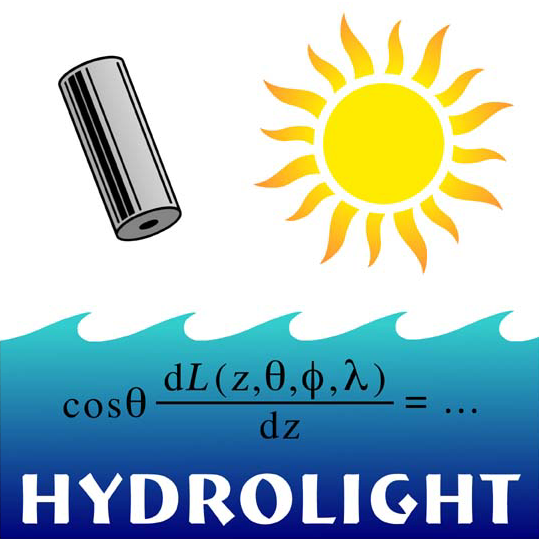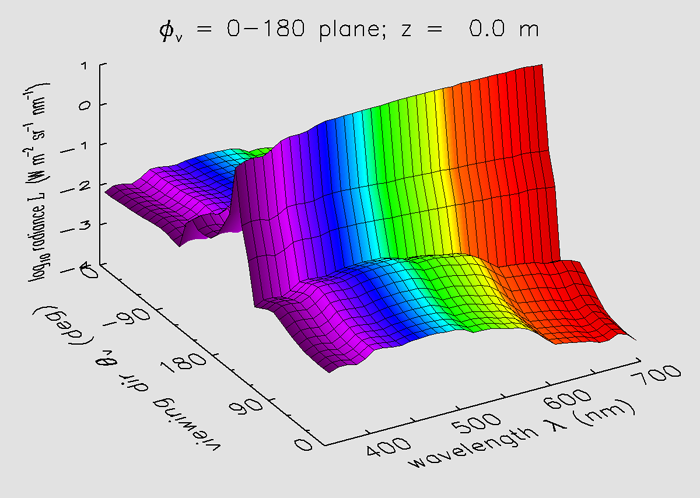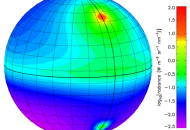HydroLight

The HydroLight radiative transfer model computes radiance distributions and related quantities such as irradiances, reflectances, diffuse attenuation functions, etc., in any water body.
HydroLight is the industry standard hydrological optics model and has been in use world-wide for over 30 years. Users can specify the water absorption and scattering properties, the sky conditions, and the bottom boundary conditions in various ways, e.g., by selection of built-in bio-optical and sky models, by reading in user-supplied data, or by writing their own Fortran subroutines to define their input. HydroLight then solves the scalar radiative transfer equation (RTE) to compute the in-water radiance as a function of depth, direction, and wavelength. Other quantities of interest to optical oceanographers, such as the water-leaving radiance and remote-sensing reflectance, are also obtained from the computed radiances. Output is presented as ASCII (printout) files, as Excel® spreadsheets, and as digital files formatted for plotting and analysis using IDL® or other graphics programs.
HydroLight is now in version 6.0 and is available for Microsoft Windows, Apple Mac and Linux.
A detailed description of HydroLight can be found in the Ocean Optics Web Book.
Features
HydroLight is used in various ways:
As a predictive tool: What will the oceanic light field be at some time in the future?
Given a prediction of water absorption and scattering properties, HydroLight can use that information to predict the corresponding light field and oceanic reflectance.

As a sensitivity analysis tool: Which factors contribute to determining oceanic reflectance?
Many physical properties contribute to optical processes in the water column: scattering and absorption by phytoplankton and inorganic particles, chlorophyll fluorescence, Raman scattering and bioluminescence. Using HydroLight the significance and optical signatures of these factors can be investigated.
As an analysis development tool: How to extract environmental data from satellite images or sensor readings?
HydroLight can serve as a controlled environment to predict what a sensor reading would be under a wide range of conditions. HydroLight outputs can be used for parameterisation or training of analysis algorithms, to extract bio-physical properties of a water body from measurement data.
As a teaching tool:
How can someone new to the field of optical oceanography most quickly build up “intuition” or a “working knowledge” about the marine optical environment? The best way to gain such knowledge is of course to spend 20 years working as an optical oceanographer. The next best way is to use HydroLight to study how oceanic light fields depend on various environmental parameters.

The current release, HydroLight-EcoLight version 6, includes both the full HydroLight model and a specialized version of HydroLight, called EcoLight, which runs much faster than the full code but computes only irradiances and related quantities. (EcoLight, which is bundled with HydroLight and runs within the same user interface, is different from the EcoLight-S subroutine, which is designed to be embedded in the user’s own code, such as an ecosystem model. See the PDF files below for additional information about the technical specifications of HydroLight and EcoLight.
You can see many examples of HydroLight output on the Ocean Optics Web Book. Use the search function and search for "HydroLight" to find specific pages using HydroLight outputs.
Documentation
PDF documents giving more details about HydroLight can be downloaded here, including the full Users' Guide and Technical Documentation:
- Full description of HydroLight
- What is included with a HydroLight license
- HydroLight 6.0 Users' Guide
- HydroLight 6.0 Technical Documentation
- Publications using HydroLight
- Angular resolution used in HydroLight
- The RADTRAN-X Atmospheric Irradiance Model
- Using other sky radiance models with HydroLight
HydroLight was originally written by Curt Mobley and was formerly a product of Sequoia Scientific. In 2017 John Hedley of Numerical Optics Ltd. took over of the development and maintenance of HydroLight. Information about the handover is given in the following document:
Support requests from existing users and any other queries about HydroLight should now be directed to John Hedley j.d.hedley@numopt.com.